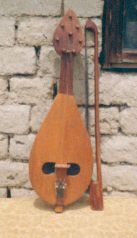|
|
Stringed Instruments
|
 |
Bowing: gadoulka (kopanka, ghiola,
kasnak)
Gadoulka is a Slavonic stringed instrument without a fingerboard as
it is in the current violin. Strings are not with one and the same length
and the same height. The first string is the lowest, the second is longer
and higher and the third is the highest. Usually gadoulkas have three
of four strings. In some there are further, thinner metallic strings
conforming to the tones, which are played on the instrument with fingers.
The folk gadoulka player calls these strings under-sounds that make
resonance. Their purpose is to resonate on tones which in the gadoulka
sound more deafly and not clearly. As playing on a violin fingers press
the strings against the fingerboard still in difference, playing on
gadoulka without a fingerboard, fingers, instead of playing onto the
strings, touch them with nails. The sonority of gadoulka in comparison,
with the sonority of violin is more quiet and deafer, but more pleasant.
Possibilities of tones are from "sol" on the little octave still "re"
on the second octave.
|
 |
Stringing instruments: tamboura (dranakia,
dzunga, bailama)
The tamboura in comparison with the other musical folk instruments is
not so diffused as gadoulka. There are tamburas with the different extent
very often in the region of Raslog, Gotse Delchev and others. All tamboura's
strings are metallic with one and same thickness and are puled with
a plectrum, which often is called with the Turkish name "tesane". There
are tambouras with two, three, six and eight strings and other with
twelve. Folk orchestras are used in utilising the six-stringed tamboura,
whose strings are with different thickness and are disposed in three
groups too. The violin key is written with notes and has a volume from
"la" on the little octave still "la" on the second octave.
|
|
| |
|
|
|